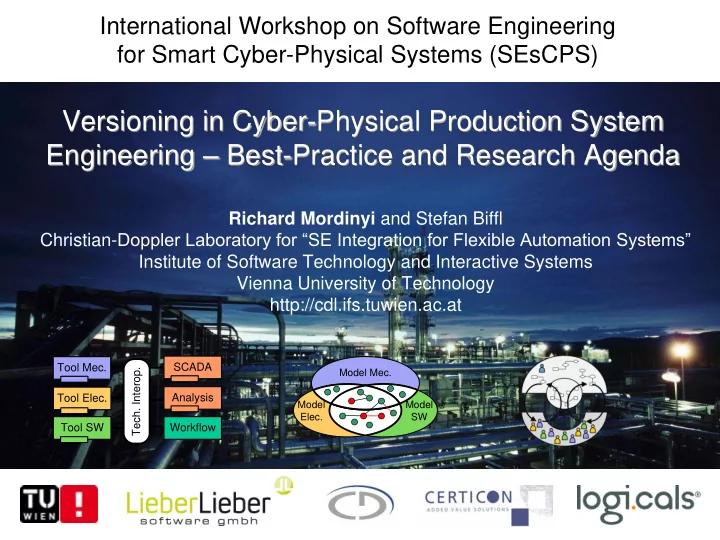

International Workshop on Software Engineering for Smart Cyber-Physical Systems (SEsCPS) Versioning in Cyber-Physical Production System Engineering – Best-Practice and Research Agenda Richard Mordinyi and Stefan Biffl Christian- Doppler Laboratory for “SE Integration for Flexible Automation Systems” Institute of Software Technology and Interactive Systems Vienna University of Technology http://cdl.ifs.tuwien.ac.at SCADA Tool Mec. Tech. Interop. Model Mec. Tool Elec. Analysis Model Model Elec. SW Tool SW Workflow
Motivation & Background Motivation: Large-Scale Engineering Projects, e.g., hydro power plants, car manufacturing plants, steel mills. Cooperation of different engineering disciplines. Disciplines have specific engineering tools. Manual effort required for data exchange and synchronization (high risks). Key research questions focus on: domain experts and researchers in ASE environments with a set of concepts, methods, and tools to make informed decisions on top of integrating engineering knowledge to design advanced applications for mitigating risks of defects in the engineering of flexible automation systems 2
Position of Research in CPS Concept Map 3 http://cyberphysicalsystems.org
Characteristics of Automation Systems Engineering Limited engineering process analysis and improvement capabilities Engineering processes seem sequential but have loops back. Heterogeneous knowledge representations in diverse engineering models. Fragile change management in parallel multi-disciplinary engineering. Insufficient early risk management in a heterogeneous environment. 4 VDI: 'Engineering of industrial plants. Evolution and Optimizations. Part 1-4, Verein Deutscher Ingenieure e.V., VDI/VDE 3695, 2010. VDI Richtlinie 2206 – Entwicklungsmethodik für mechatronische Systeme, VDI Verlag, 2004.
Industry 4.0: Engineering Knowledge at Run Time Engineering Phase Test/Operation Phase Business Requirements Integrate Business ERP System Business Requirements in Engineering Tool Data Enrich runtime Manager information OPC UA Server Engineering Engineering (augmented) Project Cockpit Project C Cockpit Manager Manager Production CAD, Pipe & Multi-Model Production Multi-Model C Project-level C Project-level Manager Instrumentation Dashboard Planning Dashboard concepts concepts Process Eng. Tool Data Tool Data Tool Data Tool Data Project Project Participant Software Dev. Participant Diagnosis C C Electrical Plan Automation C SCADA RT-Automation C Environment Analysis Service Bus Service Bus Tool Data Tool Data Tool Data Tool Data Electrical Eng. Operator Diagnosis Software Eng. C Expert C PLC program C PLC program Tool Data Control Eng. Tool Data Control Eng. Access run-time information Access engineering information PLC Cyber Physical Production Cyber Physical Production Deploy created artifacts OPC UA Server System (CPPS) System (CPPS) Config Sales Production Transport Sales Production Transport Flexibility increases system complexity Need for better integrated engineering to cope with larger solution space and with system changes at run time – commissioning 5
Version Management of Mechatronic Objects Versioning of various semantic model element levels – File, Folders, Structural Elements, and detailed content levels File-Level Versioning not sufficient – reflects data format syntax Detection of Changes at Model-level 6 6
Summary & Research Aspects Engineering of sCPS needs to cope with multiple heterogeneous engineering domains Data heterogeneity integration – Methods, tools and modeling approaches of various domains – Access to domain specific model data from project/process level Versioning and linking of engineering artifacts – Scalability of framework in managing versions – Formulation of cross-domain queries with domain-specific knowledge Model-driven engineering – Modeling permitted changes of the production system during runtime – Modeling corridor of allowed changes – Formalization of operator’s knowledge to support automation 7
Recommend
More recommend